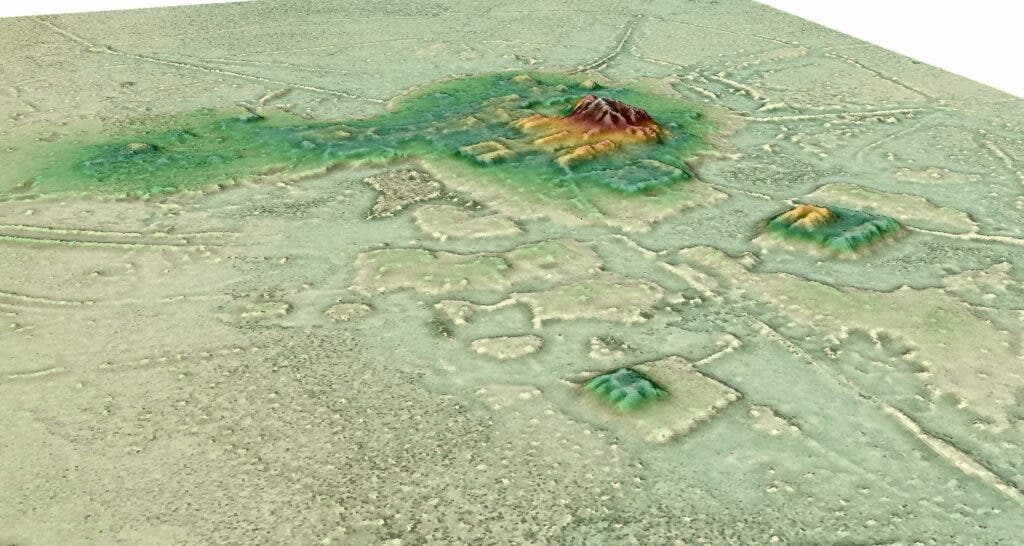Researchers have discovered mysterious mounds that were once ancient urban settlements. Dating back some 1,500 years, these settlements (featuring intricate roads, platforms, and even pyramids) are strikingly complex and hint at a thriving civilization.
No one really expected something like that.
“Nobody expected that kind of society in that region … pyramids 20 meters high,” said study author Heiko Prümers, of the German Archaeological Institute, in a video produced by Nature. “The whole region has been so densely habitated during the pre-hispanic time, that’s incredible to believe. There is a new civilization, new culture, waiting for us to study them.”

Exploring the Amazon is not easy. Archaeologists have, understandably, struggled to cover the vast forests of the Amazon. Sometimes, cities are visible and fairly easy to discover. Other times, they’re covered by thick vegetation that makes it nigh impossible to spot with the naked eye.
But technology can help.
Remote sensing equipment aboard helicopters or drones can send tens of thousands of laser pulses in a multitude of directions, carefully monitoring when and how these pulses are reflected back to the equipment. By calculating the distance (or the range) in all possible directions, researchers can map the surface even through thick vegetation like in the Amazon.
It’s called Lidar (light detection and ranging), and it’s been used quite a lot recently to peer through the vegetation and look for archaeology. Sometimes, researchers use Lidar and find an interesting mound or some monuments — but sometimes, as is the case here, you find entire cities.
The new discovery features 11 previously unknown settlements of the Casarabe culture, which dates to around AD 500 to AD 1400, in south-west Amazonia. The findings represent urban areas that suggest the western Amazon wasn’t as sparsely populated as previously thought.

Not a green desert
For a long time, archaeologists suspected that the Amazon soil was unsuitable to support large-scale agriculture; and in turn, unsuitable for any tropical civilizations to develop. But in the early 2000s, that started to change. Some researchers were increasingly finding archaeological traces, as well as signs of domesticated plants across the Amazon. Then, when remote sensing became more dependable, things really started to change.
In the past five years alone, researchers have uncovered hundreds of settlements and structures belonging to various pre-Hispanic cultures in the Amazon, finding that the Amazon was dotted with plenty of settlements.
The Casarabe culture, like many others inhabiting the Amazon area, is not well understood. Dense vegetation makes on-site study difficult, and they were mostly known from a few isolated settlements. Now, researchers have mapped two large urban areas and 24 smaller ones (of which only 15 were previously known). The researchers analyzed the architecture of these areas, finding a complex network of canals and reservoirs, as well as U-shaped structures, platform mounds, and conical pyramids, some of which were up to 22 meters tall (72 feet). The religious beliefs of the Casarabe are not well understood, but it’s likely that these large structures had some religious purpose — especially because they are aligned in a north-northwest direction, the same direction as the uncovered Casarabe graves.
“All these settlements are embedded in a human-engineered landscape with a massive water-control system designed to maximize food surpluses to support the large Casarabe population. This system both stored and diverted water, depending on the season and the needs of farmers. The reservoirs might have served as fish ponds, providing a crucial resource for subsistence,” writes Christopher T. Fisher, professor of anthropology at Colorado State University, in an accompanying News and Views article.

When Spanish missionaries arrived in the 16th century, they found only isolated communities living there. Some previous explorers had described a network of towns and villages, but they seemed impossible to find for later explorers and colonizers. So what happened to the Casarabe?
The civilization apparently met its demise over a century before the arrival of the Spanish. Prümers speculates that water scarcity may have had something to do with it — since water management seemed to play such a prominent role for them, it’s possible that water availability was crucial. If a prolonged drought took place or something happened to disrupt water availability, it could have been devastating. But more research is needed to confirm this.
Researchers plan to eventually go down to the sites and study them “manually”, but this will take time and resources. In addition, these regions are threatened by deforestation.
When the bulldozers sweep in, they don’t just destroy the trees, they also destroy any archaeological remains. We may be losing these ancient settlements just as we were starting to discover them.

The study was published in Nature.


